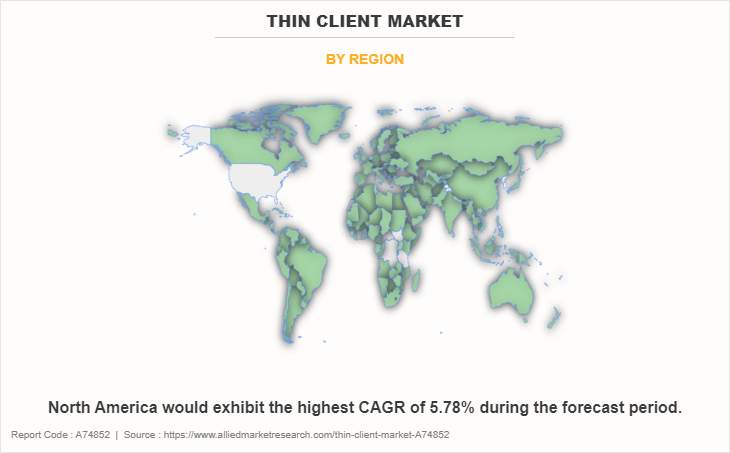Thin Client Market Research, 2032
The global thin client market was valued at $1.6 billion in 2022 and is projected to reach $2.6 billion by 2032, growing at a CAGR of 4.8% from 2023 to 2032.
A thin client is a type of computer that operates similarly to a regular desktop or laptop but does not have a built-in hard drive for data storage. Instead, it relies on an operating system (OS) and application software installed on it. Thin Clients utilize "terminal services" (TS) to send requests over local area networks (LAN) to centralized servers to access information and applications.

Thin clients are equipped with a local operating system and flash memory, but they store all applications and data on a central server. They offer features such as local printing, device support, web browsing, and network computing. These devices provide a cost-effective solution for companies, as they can operate efficiently within a budget. With advancements in connection protocols, thin clients and virtual desktops can deliver enhanced performance and productivity for businesses. One notable advantage for thin client users is the client management console, which is a virtual tool for remote management of deployed devices. It enables the creation, cloning, and display of customized images for thin clients. It is important to note that different thin clients support varying workloads, with some protocols offering better video streaming capabilities than others. For example, while VNC may have limitations in video streaming, a web browser with Flash support can provide full-screen H.264 video playback on the same network connection. In addition, it is possible to access a VNC connection through a web browser using a Java-based browser applet with similar speed and features as the binary client.
Segmentation Overview
The thin client market is segmented into Application and Form Factors.
By application, the thin client market is segregated into enterprise, government, education, industrial, and healthcare. The government segment is projected to exhibit the highest CAGR during the forecast period.

By form factor, the thin client market is divided into standalone, with monitor, and mobile. The standalone segment accounts for the largest share during the forecast period.

By region, the market is analyzed across North America (U.S., Canada, and Mexico), Europe (UK, Germany, France, and Rest of Europe), Asia-Pacific (China, Japan, India, South Korea, and Rest of Asia-Pacific), and LAMEA (Latin America, Middle East, and Africa).

Country-wise, the U.S. acquired a prime market share in the North American region and is expected to grow at a significant CAGR during the forecast period of 2023-2032. This strong position can be attributed to the presence of several well-established thin client solution providers within the country. Notably, a recent partnership between HP Inc. and Citrix aims to deliver secure and efficient thin client solutions, focusing on enhancing remote work capabilities and seamless access to virtual desktops and applications. Another significant development is Microsoft's expansion of its Windows Virtual Desktop (WVD) service in the U.S., enabling organizations to leverage thin clients for remote work and access Windows desktops and applications from any device. These advancements reflect the growing demand for flexible and remote-friendly IT infrastructure solutions in the U.S., further strengthening its prime position in the North American thin client market.
In Europe, the UK, dominated the thin client market share, in terms of revenue, in 2022 and is expected to follow the same trend during the forecast period. The UK National Health Service (NHS) has played a pivotal role in driving the adoption of thin clients in healthcare settings, aiming to enhance efficiency and patient care. An excellent example is the implementation of thin client technology by the University Hospitals Birmingham NHS Foundation Trust, which has streamlined access to electronic patient records and medical applications. This enables healthcare professionals to deliver timely and accurate care, ultimately improving patient outcomes. The proactive approach of the UK NHS in adopting thin clients reflects the country's leadership position in the European thin client market industry and its commitment to leveraging innovative technologies for the benefit of healthcare delivery.
In the Asia-Pacific region, China is anticipated to become a prominent market for the thin client industry. One noteworthy trend driving this growth is the increasing focus on cloud computing and virtualization in the country. The education sector in China, in particular, has played a pivotal role in driving the adoption of thin clients. In 2020, the Chinese Ministry of Education announced a nationwide initiative to implement cloud computing and thin client technology in schools. This initiative aims to enhance digital learning capabilities by providing students with access to educational resources and virtual classrooms facilitated by thin clients. This significant investment in thin client technology in the education sector underscores China's commitment to advancing its digital infrastructure and fostering a technology-enabled learning environment for its students.
In the LAMEA region, Latin America dominated the thin client market size, in terms of revenue, in 2022 and is expected to follow the same trend during the forecast period. The key driver for this dominance is the increasing adoption of cloud-based solutions and virtual desktop infrastructure (VDI) in the region. In recent news, Dell Technologies announced a partnership with Telefonica, a leading telecommunications company in Latin America, to offer VDI solutions to businesses in the region. This collaboration aims to provide secure and efficient access to virtual desktops and applications through thin clients, catering to the growing demand for remote work and digital transformation.
The cost-effectiveness of thin clients is a strong driver in the growth of the thin client market industry. Their ability to lower the total cost of ownership (TCO) compared to traditional desktops or laptops makes them highly attractive to organizations. Thin clients have lower upfront costs due to their simpler hardware configurations and reliance on server resources for processing and storage. This translates to significant savings, particularly when deploying a large number of devices. Furthermore, thin clients require less hardware maintenance due to their streamlined design and centralized management, resulting in reduced operational expenses over time. Their lower power consumption not only contributes to cost savings but also aligns with energy efficiency goals, reducing electricity costs for organizations. In addition, thin clients typically have longer lifespans, reducing the frequency of hardware replacements and further driving down expenses. By providing a cost-effective solution, thin clients have established themselves as a favorable choice for organizations looking to optimize their IT investments and minimize overall expenses, fueling the thin client market growth.
However, one of the major restraints in the thin client market is network dependency. Thin clients rely on network connectivity to access applications and data stored on centralized servers. Any disruptions or issues with the network can impact user productivity and access to critical resources. To overcome this challenge, organizations must prioritize the establishment of a reliable and robust network infrastructure. This involves ensuring sufficient bandwidth capacity, low latency, and network redundancy. Regular monitoring and maintenance are also essential to promptly identify and address any network issues. By addressing network dependency, organizations can enhance the performance and reliability of thin clients, improving the user experience and productivity.
The thin client market presents a significant opportunity for organizations to embrace and empower remote work. With the increasing trend of remote and flexible work arrangements, thin clients offer an ideal solution for enabling a productive and collaborative remote workforce. By securely accessing their desktop environment and applications from any location, employees can work seamlessly using any device with network connectivity. This flexibility allows individuals to choose their preferred work environment, whether it's their home, a co-working space, or while traveling. Thin clients facilitate easy collaboration among distributed teams by enabling smooth file sharing and access to centralized resources. This remote work enablement not only helps organizations attract and retain top talent but also enhances work-life balance and overall workforce productivity. By leveraging thin clients, businesses can adapt to the evolving work landscape and unlock the benefits of a remote workforce.
Zero clients, on the other hand, are a specific type of thin client computing device that offers a streamlined and efficient approach to accessing virtual desktops. In contrast to traditional thin clients, zero clients have minimal processing power and storage as they heavily rely on the server for computing and storage capabilities. Designed to be simple, energy-efficient, and cost-effective, zero clients are an attractive option for organizations seeking to deploy virtual desktop infrastructure (VDI) solutions. With zero clients, users can securely access their virtual desktops and applications from any location, while IT administrators benefit from centralized management and enhanced security. Utilizing zero clients can help reduce hardware costs, simplify IT maintenance, and ensure a consistent user experience across various devices.
Top Impacting Factors
The rise in the adoption of cloud-based services is driving the demand for thin client solutions as businesses migrate to the cloud. Thin clients provide efficient access to cloud-hosted applications and data, aligning with cost-effectiveness and energy efficiency goals. Centralized data storage and backup further enhance the appeal of thin clients by improving data management, reducing the risk of data loss, and simplifying disaster recovery processes. However, customization limitations pose a challenge for organizations with unique requirements, hindering their ability to tailor thin clients to their specific needs. On the other hand, the increasing investments in data centers by leading corporations present an opportunity for the thin client market, driven by the growing demand for storage capacity resulting from digital transformation.
Competitive Analysis
The thin client market outlook is highly competitive, owing to the strong presence of existing vendors. Vendors of the thin client market with extensive technical and financial resources are expected to gain a competitive advantage over their competitors because they can cater to market demands. The competitive environment in this market is expected to increase as product launches, collaboration, and agreements such different strategies adopted by key vendors increase. Competitive analysis and profiles of the major thin client market players that have been provided in the report include Dell Inc., HP Development Company, L.P., Fujian Centerm Information Co., Ltd., Fujitsu, LG Electronics, Advantech Co., Ltd., Siemens, IGEL, OnLogic, and Thinvent.
Key Developments/ Strategies
According to the latest thin client market forecast, LG Electronics, Dell Inc., HP Development Company, L.P., Fujitsu, and Advantech Co., Ltd. are the top 5 key players in the thin client market. Top market players have adopted various strategies, such as product launches, collaboration, and agreements to expand their foothold in the thin client market.
In April 2022, Dell Technologies introduced the OptiPlex 3000 Thin Client, featuring a reliable and durable design similar to their business desktops. The thin client is compatible with various operating systems, including Dell ThinOS, Ubuntu Linux, and Windows 10 IoT Enterprise. It is designed to cater to teams of all sizes in front and back-office environments. The device is compact, highly configurable, fan-less, and can be easily mounted using a wide range of stands and mounts.
In November 2021, Fujitsu introduced its new FUTRO lineup of thin clients, which now includes devices equipped with AMD Ryzen R1000 series processors. These sleek and compact models bring enhanced memory capacity and utilize fast, PCIe-based SSD drives. According to Fujitsu, the latest Fujitsu Thin Client FUTRO S-series models offer improved memory capacity and faster storage compared to the previous generation.
In December 2021, LG Business Solutions and IGEL have partnered to integrate IGEL OS on a range of LG All-in-One Thin Clients. This collaboration is the result of the validation process of selecting LG All-in-One Thin Clients as part of the IGEL Ready Program.
Key Benefits For Stakeholders
- This report provides a quantitative analysis of the market segments, current trends, estimations, and dynamics of the thin client market analysis from 2022 to 2032 to identify the prevailing thin client market opportunity.
- The market research is offered along with information related to key drivers, restraints, and opportunities.
- Porter's five forces analysis highlights the potency of buyers and suppliers to enable stakeholders to make profit-oriented business decisions and strengthen their supplier-buyer network.
- An in-depth analysis of the thin client market segmentation assists in determining the prevailing market opportunities.
- Major countries in each region are mapped according to their revenue contribution to the global market.
- Market player positioning facilitates benchmarking and provides a clear understanding of the present position of the market players.
- The report includes an analysis of the regional as well as global thin client market trends, key players, market segments, application areas, and market growth strategies.
Thin Client Market, by Form Factor Report Highlights
| Aspects | Details |
| Market Size By 2032 | USD 2.6 billion |
| Growth Rate | CAGR of 4.8% |
| Forecast period | 2022 - 2032 |
| Report Pages | 209 |
| By Application |
|
| By Form Factor |
|
| By Region |
|
| Key Market Players | Fujitsu, Fujian Centerm Information Co., Ltd., Advantech Co., Ltd., IGEL, Thinvent Technologies, OnLogic LLC, HP Development Company, L.P., LG Electronics, Siemens, Dell Inc. |
Analyst Review
The global thin client market is poised to experience significant growth in the coming years due to the cost-effectiveness of thin clients attracts organizations looking for efficient computing solutions with reduced upfront costs and lower maintenance expenses. Secondly, the enhanced security features of thin clients, such as centralized data storage and improved access control, address growing concerns about data protection. In addition, the rise of remote work and virtualization has increased the demand for thin clients, enabling employees to access their virtual desktops and applications securely from anywhere.
In 2022, Asia-Pacific dominated the thin client market, driven by the presence of major players in the region. The North America region is expected to exhibit the highest compound annual growth rate (CAGR) due to the increase in the adoption of thin clients in various fields. The region's proactive approach toward embracing cloud computing, virtualization technologies, and remote work further contributes to the rise in demand for thin clients. The market is projected to experience significant expansion, solidifying its position as a key player in the global thin client market as organizations in the region recognize the advantages of thin clients in terms of flexibility, scalability, and productivity.
The Thin Client Market is expected to grow at a CAGR of 4.8% from 2023-2032.
Healthcare is the leading application of Thin Client Market.
Asia-Pacific is the largest regional market for Thin Client.
The industry size of Thin Client is estimated to be $1,623.1 million in 2022.
LG Electronics, Dell Inc., HP Development Company, L.P., Fujitsu, and Advantech Co., Ltd. are the top companies to hold the market share in Thin Client.
Loading Table Of Content...
Loading Research Methodology...



